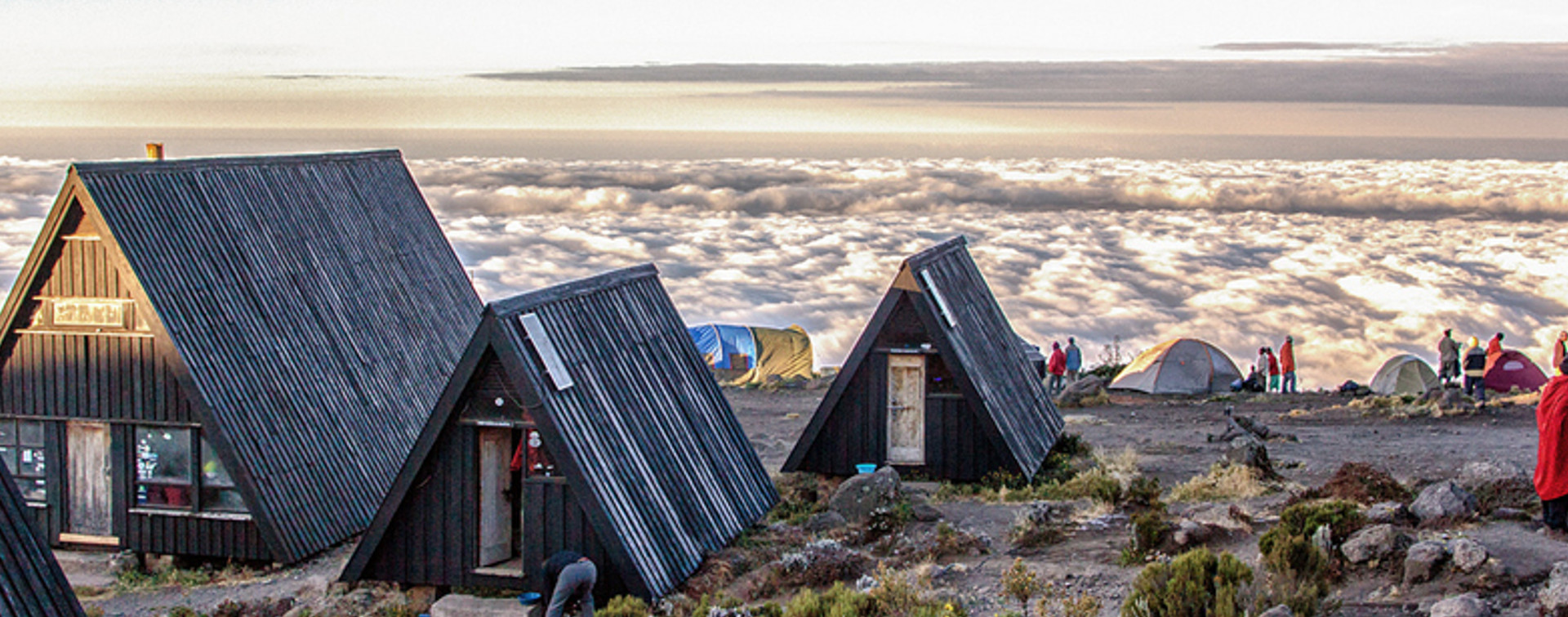Mount Kilimanjaro, Africa’s highest peak, offers climbers a range of routes, each with its own unique features and challenges. Among these, the Marangu Route stands out as one of the most popular and well-established paths to the summit. Known for its relatively straightforward ascent and hut accommodation, the Marangu Route provides a classic Kilimanjaro experience. This guide delves into the details of the Marangu Route, including its itinerary, key features, preparation tips, and why it might be the ideal choice for your Kilimanjaro adventure.
Overview of the Marangu Route
The Marangu Route, often referred to as the “Coca-Cola Route” due to its popularity and ease, is the oldest and most traditional route on Mount Kilimanjaro. Starting from the southeastern side of the mountain, this route is renowned for its relatively gradual ascent and the availability of hut accommodation at each camp. It is considered one of the easier routes to the summit, though it still requires significant preparation and physical fitness.
Route Highlights
- Hut Accommodation: Unlike other routes that use tents, the Marangu Route offers hut accommodation at each campsite, providing a more comfortable and sheltered experience.
- Gradual Ascent: The route’s gradual ascent makes it a popular choice for climbers seeking a less strenuous climb compared to other routes.
- Classic Experience: As the oldest and most traditional route, the Marangu Route provides a classic Kilimanjaro experience with a well-trodden path and well-established infrastructure.
Marangu Route Itinerary
The Marangu Route typically takes 5 to 6 days to complete. Here is a detailed day-by-day breakdown of a standard 5-day Marangu Route climb:
Day 1: Marangu Gate to Mandara Hut
- Distance: Approximately 8 kilometers (5 miles)
- Duration: 4-5 hours
- Altitude: Start at 1,800 meters (5,905 feet); Hut at 2,700 meters (8,858 feet)
The trek begins at the Marangu Gate, where climbers complete park formalities. The route ascends through lush rainforest, characterized by its rich biodiversity and vibrant greenery. The path is relatively gentle, leading to Mandara Hut, where climbers can rest and acclimate to the altitude.
Day 2: Mandara Hut to Horombo Hut
- Distance: Approximately 12 kilometers (7.5 miles)
- Duration: 5-7 hours
- Altitude: Hut at 3,700 meters (12,136 feet)
The second day’s trek involves a steady ascent through the moorland zone, with increasing views of the surrounding landscape. The terrain transitions from dense forest to open heathland, and climbers reach Horombo Hut, located on a plateau with expansive views of the mountain.
Day 3: Horombo Hut to Kibo Hut
- Distance: Approximately 10 kilometers (6.2 miles)
- Duration: 5-7 hours
- Altitude: Hut at 4,700 meters (15,420 feet)
On this day, climbers continue their ascent into the alpine desert zone. The path is more arid and barren, and the air becomes thinner. Kibo Hut, situated on the edge of the Kibo Crater, serves as the base camp for the summit attempt. Climbers use this time to rest and prepare for the challenging final ascent.
Day 4: Kibo Hut to Uhuru Peak and Descend to Horombo Hut
- Distance: Approximately 6 kilometers (3.7 miles) to the summit; 15 kilometers (9.3 miles) to descend
- Duration: 12-15 hours
- Altitude: Summit at 5,895 meters (19,341 feet); Return to 3,700 meters (12,136 feet)
Summit day begins early, with climbers starting their ascent to Uhuru Peak in the early hours of the morning. The trek involves a strenuous climb up the steep slope of the crater rim. After reaching the summit and celebrating the achievement, climbers descend back to Horombo Hut for rest and recovery.
Day 5: Horombo Hut to Marangu Gate
- Distance: Approximately 20 kilometers (12.4 miles)
- Duration: 6-8 hours
- Altitude: Descend from 3,700 meters (12,136 feet) to 1,800 meters (5,905 feet)
The final day involves a descent from Horombo Hut back to the Marangu Gate. The trek takes climbers through lush forest terrain, providing a chance to reflect on the climb and enjoy the verdant surroundings. At the gate, climbers complete their descent and celebrate their successful journey.
Key Features of the Marangu Route
Hut Accommodation
One of the main attractions of the Marangu Route is the availability of hut accommodation. Unlike other routes that use tented camps, the Marangu Route features basic but comfortable huts with bunk beds and shared facilities. This option provides added comfort and protection from the elements, particularly during the night.
Gradual Ascent
The Marangu Route’s gradual ascent is designed to minimize the risk of altitude sickness. The route’s steady climb allows climbers to adapt to the increasing altitude more gradually compared to steeper routes. This makes it a popular choice for climbers seeking a less demanding climb.
Classic Kilimanjaro Experience
As the oldest and most traditional route, the Marangu Route offers a classic Kilimanjaro experience. The well-established infrastructure, including the huts and well-marked trail, provides a sense of history and tradition. Climbers can follow in the footsteps of countless adventurers who have successfully reached the summit via this route.
Relatively Short Duration
The Marangu Route is typically completed in 5 to 6 days, making it one of the shorter routes on Kilimanjaro. This duration appeals to climbers with limited time or those seeking a more condensed adventure. Despite its shorter length, the route still provides a comprehensive Kilimanjaro experience.
Preparing for the Marangu Route
Physical Fitness
Preparation for the Marangu Route requires a good level of physical fitness. Engage in cardiovascular training, strength building, and endurance exercises to prepare for the demands of the climb. Incorporate hiking, trekking, and climbing into your training regimen to simulate the conditions you’ll encounter on Kilimanjaro.
Gear and Equipment
Proper gear is essential for a successful Marangu Route climb. Key items include:
- Layered Clothing: Moisture-wicking base layers, insulating layers, and waterproof outer layers to handle varying weather conditions.
- Trekking Poles: Adjustable trekking poles to aid with balance and reduce strain on your knees.
- High-Quality Footwear: Sturdy, waterproof hiking boots with good ankle support.
- Sleeping Gear: A sleeping bag rated for cold temperatures and a lightweight sleeping pad for warmth and comfort.
Acclimatization Strategy
Follow the acclimatization recommendations provided by your guide. Although the Marangu Route’s gradual ascent helps with acclimatization, it is still important to stay hydrated, eat well, and listen to your body. Communicate any symptoms of altitude sickness to your guide promptly.
Travel and Health Insurance
Obtain comprehensive travel and health insurance that covers high-altitude climbing and emergency evacuation. Ensure that your insurance policy includes coverage for medical treatment and rescue operations.
Choose a Reputable Tour Operator
Select a reputable tour operator with experience and positive reviews. A knowledgeable guide and a well-organized team will enhance your climbing experience and ensure safety throughout the trek.
Why Choose the Marangu Route?
The Marangu Route offers a range of benefits that make it an attractive option for many climbers. Here are some reasons why it might be the ideal choice for your Kilimanjaro adventure:
Comfortable Hut Accommodation
The availability of hut accommodation provides added comfort and shelter compared to tented camps. This can be particularly appealing for climbers who prefer a more comfortable experience or are concerned about weather conditions.
Gradual Ascent and Acclimatization
The Marangu Route’s gradual ascent minimizes the risk of altitude sickness and allows climbers to adapt to the increasing altitude more effectively. The route’s steady climb is designed to enhance acclimatization and increase the chances of a successful summit.
Classic Kilimanjaro Experience
As the oldest and most traditional route, the Marangu Route offers a classic Kilimanjaro experience with a well-trodden path and historical significance. Climbers can experience the rich heritage of Kilimanjaro climbing while enjoying the route’s established infrastructure.
Shorter Duration
The Marangu Route’s relatively short duration appeals to climbers with limited time or those seeking a more condensed adventure. Despite its shorter length, the route provides a comprehensive Kilimanjaro experience with a successful summit attempt.
Conclusion
The Marangu Route offers a classic and accessible path to the summit of Mount Kilimanjaro. With its comfortable hut accommodation, gradual ascent, and well-established infrastructure, it is a popular choice for climbers seeking a traditional Kilimanjaro experience. Proper preparation, physical fitness, and attention to acclimatization are key to a successful climb. By choosing the Marangu Route and partnering with a reputable tour operator, you can embark on an unforgettable journey to Africa’s highest peak and achieve the remarkable feat of standing at the summit of Mount Kilimanjaro.




